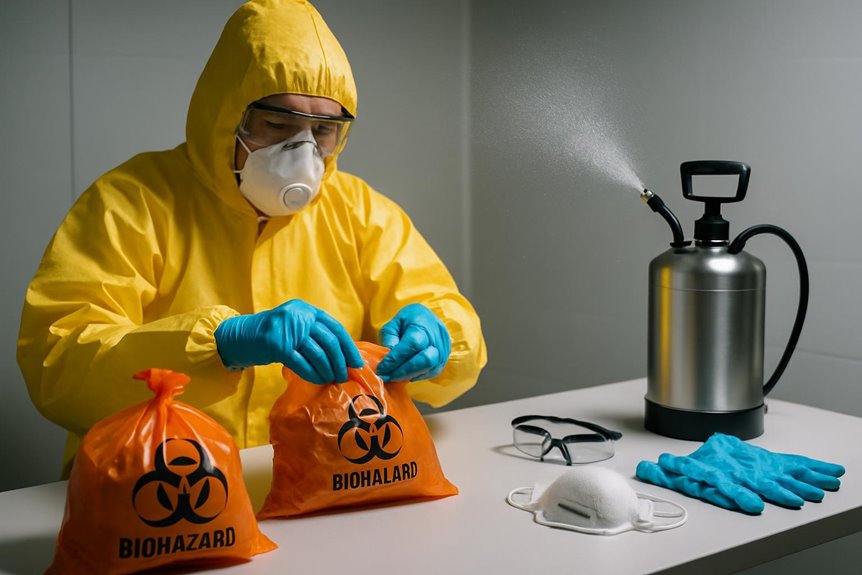Biohazard cleanup is a critical process that requires careful attention to detail and safety. It involves three essential steps: evaluating the situation, implementing safety measures, and executing thorough cleanup and disinfection. Each step is crucial for ensuring a safe environment for all. Understanding these steps can help mitigate risks associated with biohazard materials. Nevertheless, the intricacies of each phase reveal much more than just basic procedures. What lies beneath these essential actions?
Key Takeaways
- Conduct a thorough hazard assessment to identify biological materials and contaminants before initiating cleanup.
- Implement safety measures by wearing appropriate protective gear and establishing physical barriers around the affected area.
- Engage professional biohazard cleanup services to ensure compliance with safety regulations and protocols.
- Execute a detailed cleanup using specialized techniques and approved disinfectants to eradicate harmful pathogens.
- Provide support and resources to affected individuals, fostering a sense of safety and restoring the environment.
Assess the Situation and Identify Hazards
When addressing a biohazard cleanup, it is vital to first assess the situation and identify potential hazards present at the site.
This process begins with thorough hazard identification, which involves examining the area for biological materials, chemical substances, or any other contaminants that may pose a risk. Understanding the types of biohazardous materials, such as infectious agents or bodily fluids, is crucial for proper handling.
Professionals conduct a risk evaluation to determine the severity and scope of these hazards. By understanding the nature of the biohazard, they can prioritize actions and allocate resources effectively.
This initial assessment not only guarantees the safety of personnel and the public but also lays the foundation for a successful cleanup. Additionally, employing expert biohazard cleanup services ensures that all necessary protocols are followed to mitigate risks during the cleanup process.
An informed approach empowers individuals to reclaim their space, fostering a sense of freedom and peace of mind in the aftermath of a hazardous event.
Implement Safety Measures and Containment
Effective implementation of safety measures and containment strategies is crucial in a biohazard cleanup operation. Proper adherence to containment protocols guarantees the safety of both workers and the surrounding environment.
To achieve this, personnel must:
- Wear appropriate protective gear, including gloves, masks, and suits, to prevent exposure to hazardous materials.
- Establish physical barriers to contain the affected area, minimizing the risk of cross-contamination.
- Utilize designated waste disposal methods for biohazardous materials to guarantee safe and compliant removal.
These steps not only protect individuals involved in the cleanup but also uphold the integrity of the surrounding community. Additionally, thorough training in biohazard cleanup procedures ensures that all personnel are well-prepared to handle hazardous situations effectively.
Execute Thorough Cleanup and Disinfection
Once safety measures and containment protocols are firmly established, the focus shifts to executing a thorough cleanup and disinfection process.
This vital step employs specialized cleaning techniques tailored to effectively remove all biohazardous materials. Trained professionals utilize appropriate personal protective equipment (PPE) while systematically addressing contaminated surfaces and materials.
Following the initial cleanup, stringent disinfection protocols come into play, ensuring that harmful pathogens are eradicated. Approved disinfectants are applied according to manufacturer guidelines, taking care to cover all affected areas thoroughly.
This meticulous approach not only restores the environment to a safe state but also instills confidence in those affected. Ultimately, a successful cleanup and disinfection process empowers individuals to reclaim their space, fostering a sense of freedom and security. Additionally, the importance of suicide cleanup services cannot be overstated, as they provide essential support during difficult times.
Frequently Asked Questions
How Much Does Biohazard Cleanup Typically Cost?
The cost of biohazard cleanup varies considerably, influenced by factors such as the type of incident, location, and required materials. Cleanup pricing typically ranges from several hundred to thousands of dollars, ensuring thorough and safe remediation.
Do I Need Specialized Insurance for Biohazard Cleanup?
Specialized insurance for biohazard cleanup is often recommended. Insurance requirements vary by location, but adequate liability coverage protects against potential legal issues and financial liabilities, ensuring peace of mind for businesses and individuals engaged in such activities.
Can I Handle Biohazard Cleanup Myself?
Handling biohazard cleanup independently poses significant risks to personal safety and may lead to legal implications. Professional services guarantee compliance with regulations, protect health, and alleviate liability concerns, allowing individuals to focus on recovery without additional burdens.
What Types of Biohazards Require Professional Cleanup?
Certain biohazards necessitate professional cleanup, including infectious waste from medical facilities and chemical spills that pose health risks. Engaging experts guarantees safety and compliance, allowing individuals the freedom to focus on recovery without added concerns.
How Long Does the Cleanup Process Usually Take?
The cleanup timeline for biohazard situations varies considerably, influenced by factors such as the extent of contamination, required safety protocols, and the specific materials involved. Professional teams guarantee thoroughness, prioritizing safety and efficiency throughout the process.
Conclusion
To sum up, effective biohazard cleanup is an imperative process that demands careful assessment, stringent safety measures, and thorough disinfection. By meticulously identifying hazards and implementing appropriate containment strategies, professionals can safeguard personnel and the surrounding environment. The final step of rigorous cleanup guarantees the eradication of harmful pathogens, allowing individuals to safely return to their spaces. Adhering to these essential steps not only promotes health and safety but also restores peace of mind in the aftermath of a biohazard incident.

